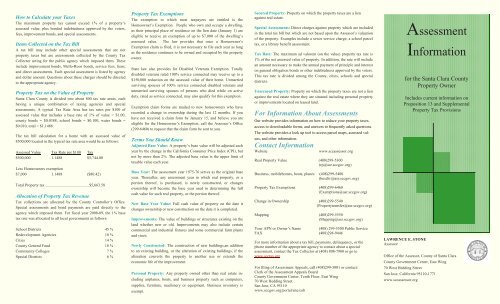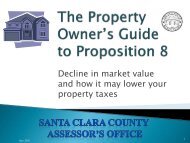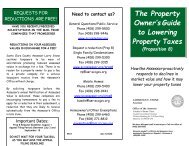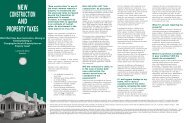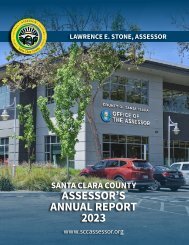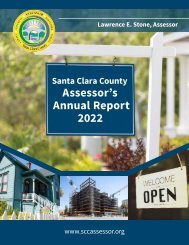Property Assessment Santa Clara County
For the Santa Clara County property owner. It includes information on Proposition 13 and the Supplemental property tax provisions.
For the Santa Clara County property owner. It includes information on Proposition 13 and the Supplemental property tax provisions.
Create successful ePaper yourself
Turn your PDF publications into a flip-book with our unique Google optimized e-Paper software.
How to Calculate your Taxes<br />
The maximum property tax cannot exceed 1% of a property‘s<br />
assessed value, plus bonded indebtedness approved by the voters,<br />
fees, improvement bonds, and special assessments.<br />
Items Collected on the Tax Bill<br />
A tax bill may include other special assessments that are not<br />
property taxes but are assessments collected by the <strong>County</strong> Tax<br />
Collector acting for the public agency which imposed them. These<br />
include improvement bonds, Mello-Roos bonds, service fees, liens,<br />
and direct assessments. Each special assessment is listed by agency<br />
and dollar amount. Questions about these charges should be directed<br />
to the appropriate agency.<br />
<strong>Property</strong> Tax on the Value of <strong>Property</strong><br />
<strong>Santa</strong> <strong>Clara</strong> <strong>County</strong> is divided into about 800 tax rate areas, each<br />
having a unique combination of taxing agencies and special<br />
assessments. A typical Tax Rate Area has tax rates per $100 of<br />
assessed value that includes a base rate of 1% of value = $1.00,<br />
county bonds = $0.0388, school bonds = $0.100, water bonds =<br />
$0.010, total = $1.1488.<br />
The tax bill calculation for a home with an assessed value of<br />
$500,000 located in the typical tax rate area would be as follows:<br />
Assessed Value Tax Rate per $100 Tax<br />
$500,000 1.1488 $5,744.00<br />
Less Homeowners exemption<br />
$7,000 1.1488 ($80.42)<br />
Total <strong>Property</strong> tax ............................................$5,663.58<br />
Allocation of <strong>Property</strong> Tax Revenue<br />
Tax collections are allocated by the <strong>County</strong> Controller‘s Office.<br />
Special assessments and bond payments are paid directly to the<br />
agency which imposed them. For fiscal year 2008-09, the 1% base<br />
tax rate was allocated to all local governments as follows:<br />
School Districts 45 %<br />
Redevelopment Agencies 10 %<br />
Cities 14 %<br />
<strong>County</strong> General Fund 18 %<br />
Community Colleges 7 %<br />
Special Districts 6 %<br />
<strong>Property</strong> Tax Exemptions<br />
The exemption to which most taxpayers are entitled is the<br />
Homeowner’s Exemption. People who own and occupy a dwelling,<br />
as their principal place of residence on the lien date (January 1) are<br />
eligible to receive an exemption of up to $7,000 of the dwelling’s<br />
assessed value. The law provides that once a Homeowner’s<br />
Exemption claim is filed, it is not necessary to file each year as long<br />
as the residence continues to be owned and occupied by the property<br />
owner.<br />
State law also provides for Disabled Veterans Exemption. Totally<br />
disabled veterans rated 100% service connected may receive up to a<br />
$150,000 reduction on the assessed value of their home. Unmarried<br />
surviving spouses of 100% service connected disabled veterans and<br />
unmarried surviving spouses of persons who died while on active<br />
duty, rated as service connected, may also qualify for this exemption.<br />
Exemption claim forms are mailed to new homeowners who have<br />
recorded a change in ownership during the last 12 months. If you<br />
have not received a claim form by January 15, and believe you are<br />
eligible for the Homeowner’s Exemption, call the Assessor’s Office<br />
(299-6460) to request that the claim form be sent to you.<br />
Terms You Should Know<br />
Adjusted Base Value: A property’s base value will be adjusted each<br />
year by the change in the California Consumer Price Index (CPI), but<br />
not by more than 2%. The adjusted base value is the upper limit of<br />
taxable value each year.<br />
Base Year: The assessment year 1975-76 serves as the original base<br />
year. Thereafter, any assessment year in which real property, or a<br />
portion thereof, is purchased, is newly constructed, or changes<br />
ownership will become the base year used in determining the full<br />
cash value for such real property, or the portion thereof.<br />
New Base Year Value: Full cash value of property on the date it<br />
changes ownership or new construction on the date it is completed.<br />
Improvements: The value of buildings or structures existing on the<br />
land whether new or old. Improvements may also include certain<br />
commercial and industrial fixtures and some commercial farm plants<br />
and vines.<br />
Newly Constructed: The construction of new buildings,an addition<br />
to an existing building, or the alteration of existing buildings, if the<br />
alteration converts the property to another use or extends the<br />
economic life of the improvement.<br />
Personal <strong>Property</strong>: Any property owned other than real estate including<br />
airplanes, boats, and business property such as computers,<br />
supplies, furniture, machinery or equipment. Business inventory is<br />
exempt.<br />
Secured <strong>Property</strong>: <strong>Property</strong> on which the property taxes are a lien<br />
against real estate.<br />
Special <strong>Assessment</strong>s: Direct charges against property which are included<br />
in the total tax bill but which are not based upon the Assessor’s valuation<br />
of the property. Examples include a sewer service charge, a school parcel<br />
tax, or a library benefit assessment.<br />
Tax Rate: The maximum ad valorem (on the value) property tax rate is<br />
1% of the net assessed value of property. In addition, the rate will include<br />
an amount necessary to make the annual payment of principle and interest<br />
on general obligation bonds or other indebtedness approved by the voters.<br />
This tax rate is divided among the <strong>County</strong>, cities, schools and special<br />
districts.<br />
Unsecured <strong>Property</strong>: <strong>Property</strong> on which the property taxes are not a lien<br />
against the real estate where they are situated including personal property<br />
or improvements located on leased land.<br />
For Information About <strong>Assessment</strong>s<br />
Our website provides information on how to reduce your property taxes,<br />
access to downloadable forms, and answers to frequently asked questions.<br />
The website provides a look up tool to access parcel maps, assessed values,<br />
and other information.<br />
Contact Information<br />
Website www.sccassessor.org<br />
Real <strong>Property</strong> Value (408)299-5300<br />
(rp@asr.sccgov.org)<br />
Business, mobilehomes, boats, planes (408)299-5400<br />
(busdiv@asr.sccgov.org)<br />
<strong>Property</strong> Tax Exemptions (408)299-6460<br />
(Exemptions@asr.sccgov.org)<br />
Change in Ownership (408)299-5540<br />
(<strong>Property</strong>transfer@asr.sccgov.org)<br />
Mapping (408)299-5550<br />
(Mapping@asr.sccgov.org)<br />
Your APN or Owner’s Name (408) 299-5500 Public Service<br />
FAX (408)298-9446<br />
For more information about a tax bill, payments, delinquency, or the<br />
phone number of the appropriate agency to contact about a special<br />
assessment, contact the Tax Collector at (408) 808-7900 or go to<br />
www.scctax.org<br />
For filing of <strong>Assessment</strong> Appeals, call (408)299-5001 or contact:<br />
Clerk of the <strong>Assessment</strong> Appeals Board<br />
<strong>County</strong> Government Center, Tenth Floor, East Wing<br />
70 West Hedding Street<br />
San Jose, CA 95110<br />
www.sccgov.org/portal/site/cob<br />
<strong>Assessment</strong><br />
Information<br />
for the <strong>Santa</strong> <strong>Clara</strong> <strong>County</strong><br />
<strong>Property</strong> Owner<br />
Includes current information on<br />
Proposition 13 and Supplemental<br />
<strong>Property</strong> Tax Provisions<br />
LAWRENCE E. STONE<br />
Assessor<br />
Office of the Assessor, <strong>County</strong> of <strong>Santa</strong> <strong>Clara</strong><br />
<strong>County</strong> Government Center, East Wing<br />
70 West Hedding Street<br />
San Jose, California 95110-1771<br />
www.sccassessor.org
What does the Assessor do?<br />
The Assessor is responsible for locating all taxable property in<br />
the <strong>County</strong>, identifying ownership, establishing a value for all<br />
property subject to local property taxation, listing the value of all<br />
property on the assessment roll, and applying all legal<br />
exemptions. Contrary to popular opinion, the <strong>Santa</strong> <strong>Clara</strong> <strong>County</strong><br />
Assessor does not compute property tax bills, collect property<br />
taxes, establish property tax laws, set rules by which property is<br />
appraised, or set property tax rates. To keep track of the taxable<br />
parcels of real property and their location, a staff of professional<br />
drafting technicians prepares and maintains a set of Assessor’s<br />
parcel maps, consisting of over 200 map books. <strong>Santa</strong> <strong>Clara</strong><br />
<strong>County</strong> contains over 460,000 property parcels. There are over<br />
75,000 changes in ownership of property annually, as reflected by<br />
deeds filed in the <strong>County</strong> Recorder’s Office. To establish the<br />
value of any parcel of property, the Assessor may need to know<br />
the purchase price (if any), the selling price of similar properties,<br />
the replacement cost, operating and repair costs, rental income<br />
the property may generate and other relevant facts affecting the<br />
property’s value.<br />
<strong>Property</strong> <strong>Assessment</strong>s and Proposition 13<br />
Passed by the voters in June, 1978, Proposition 13 is a Constitutional<br />
amendment that limits the taxation of property in<br />
California. It restricts both the tax rate and the rate of increase in<br />
valuation of real property as follows:<br />
•The maximum amount of property tax cannot exceed 1% of a<br />
property’s taxable value, plus bonds approved by the voters,<br />
service fees, improvement bonds, and special assessments.<br />
• A property’s original base value is its market value at time of<br />
acquisition. A new base value is set by reappraisal whenever<br />
there is a change in ownership or new construction. Except for<br />
change in ownership or new construction, the base value is<br />
increased by 2% per year (or less if the California CPI is less than<br />
2%).<br />
• Personal property, boats, airplanes and certain restricted<br />
properties are subject to annual reappraisal of value.<br />
Decline in Value (Proposition 8)<br />
Whenever the current value of a property declines below its upper<br />
limit as set by the adjusted base value, there will be a temporary<br />
reduction in assessed value. Each year thereafter, the value will<br />
be set at either its adjusted base value or its current value,<br />
whichever is lower. However, in any year, the current assessed<br />
value can be increased by more than 2% until the current market<br />
value equals the current adjusted base value.<br />
For more information on Proposition 8 (decline in value),<br />
go to www.sccassessor.org/prop8.<br />
Change in Ownership Reappraisals<br />
When a transfer occurs, the Assessor determines if a reappraisal is<br />
required under State law. If required, an appraisal is made to determine<br />
the new base value of the property. The sales price, if known, is a<br />
strong indicator, but not the sole factor in setting the value. The<br />
property owner is then notified of the new assessment and has the right<br />
to appeal both the value and the reappraisal decision. The reappraisal of<br />
property acquired by inheritance from an estate or living trust occurs as<br />
of the date of the death of the former owner, not on the date of<br />
distribution to the beneficiary. An assessment will be made in the name<br />
of the estate even if the property is sold rather than distributed to the<br />
heirs.<br />
Exclusions from Reappraisal<br />
Some changes in ownership can be excluded from reappraisal, if a<br />
timely claim is filed with the Assessor’s Office. Claim forms are<br />
available on-line at www.sccassessor.org. Some of the common<br />
exclusions include: 1) the transfer of property between parents and<br />
children, 2) replacement of a principal residence by a disabled person,<br />
3) senior citizens over age 55 who replace their principal residence with<br />
one of equal or lesser value. If the replacement residence is not in <strong>Santa</strong><br />
<strong>Clara</strong> <strong>County</strong>, the Assessor of the new county should be contacted to<br />
determine if a transfer of the base value will be accepted.<br />
Preliminary Change in Ownership Report<br />
State law requires the transferee to file a Preliminary Change in<br />
Ownership Report with the <strong>County</strong> Recorder (PCOR) when recording<br />
certain documents. Failure to file this form will result in an additional<br />
recording fee of $20.00. Information furnished on this form is needed<br />
to assist the Assessor in fulfilling certain legal responsibilities. It is not<br />
a public document.<br />
New Construction Reappraisal<br />
Copies of all building permits are forwarded to the Assessor by each<br />
city and the <strong>County</strong>. If the construction is new (such as a room<br />
addition), a reappraisal is required. Maintenance work does not create a<br />
reappraisal. In appraising new construction, the market value is<br />
determined and added to the value of the existing property. The<br />
appraised value of the existing property does not change.<br />
Important Dates for <strong>Property</strong> Owners<br />
When notified of the value of new construction, the property owner<br />
may appeal either the value or the reappraisal decision. Certain types of<br />
new construction for the residence of a disabled person, to add fire<br />
sprinklers, to retrofit unreinforced masonry buildings and to make disaster<br />
repairs may be excluded from reappraisal. Claim forms are<br />
available on-line or at the customer service counter.<br />
Supplemental <strong>Assessment</strong><br />
Whenever there is a reappraisal due to a change in ownership or to the<br />
completion of new construction, a Supplemental <strong>Assessment</strong> is issued.<br />
The supplemental tax bill will be based on the difference between the<br />
prior value and the new reappraisal. This value is prorated for the number<br />
of months remaining in the fiscal year ending June 30. The<br />
supplemental tax bill is separate, and in addition to, the regular tax bill.<br />
Usually, it is not prorated in escrow during purchase, nor is it paid by<br />
the lender through an impound account.<br />
Prior to the issuance of the supplemental tax bill, a notice of<br />
supplemental assessment will be mailed to the owner at the address of<br />
record. The owner has the right to file an application appealing the<br />
value or the reappraisal decision within 60 days of the date of the notice.<br />
Business Personal <strong>Property</strong><br />
Unlike real property, business property is appraised annually. All<br />
business owners must file a property statement each year detailing costs<br />
of all supplies, equipment, fixtures and improvements at each location.<br />
Business inventory is exempt from taxation.<br />
Boats and Airplanes<br />
Boats and airplanes are taxable and subject to annual appraisal. Their<br />
value is determined by reviewing the purchase price and the sales of<br />
comparable boats and airplanes. Information on their location and<br />
ownership is obtained from the Department of Motor Vehicles, the U.S.<br />
Coast Guard, Federal Aeronautics Administration and on-site inspections.<br />
January 1- The lien date for the assessment of property on the July 1- <strong>Assessment</strong> Roll delivered to the <strong>County</strong> Controller.<br />
assessment roll is 12:01 AM, on January 1 of each year. July 2- September 15– Period for filing application for assessment appeal<br />
February 15- Legal deadline to file claims timely for all exemptions hearing with the Clerk of the Appeals Board.<br />
including but not limited to, homeowner, disabled veteran, cemetery, August 31- Last day to pay unsecured taxes without penalty.<br />
church, college and welfare exemptions December 10- Last day to pay first installment of secured property taxes<br />
April 1- Deadline to file Business <strong>Property</strong> Statements. without penalty and deadline to file a late exemption for homeowners<br />
April 10-Last day to pay second installment of secured property and veterans.<br />
taxes without penalty.<br />
Mobilehomes<br />
All new mobilehomes purchased after June 30, 1980, and those on<br />
permanent foundations, are subject to property taxes. As with real<br />
property, the assessed value of mobile homes is subject to the<br />
limitations of Proposition 13. Unless voluntarily converted to local tax<br />
assessment, mobilehomes bought before June 30, 1980 are generally<br />
not subject to property taxes. Instead, license fees paid through the<br />
State Department of Housing and Community Development<br />
(1-800-952-8356) are required.<br />
Notification<br />
<strong>Assessment</strong> notices are mailed to property owners annually in late<br />
June stating the taxable value of the property. Notices are mailed to<br />
the property owner’s address as shown in the Assessor’s records. If<br />
you disagree with the Assessor’s valuation of your property, you may<br />
present to the Assessor’s Office before August 15, any pertinent<br />
information which you consider important to determine the market<br />
value of your property. If the Assessor agrees that a reduction is<br />
appropriate, the value can be corrected. After August 15, or if the<br />
Assessor does not agree to a reduction, you must file a “formal”<br />
appeal with the <strong>Assessment</strong> Appeals Board to request relief.<br />
<strong>Assessment</strong> Appeal Application<br />
For the regular tax bill, an application must be filed between July 2<br />
and September 15 with the Clerk of the Appeals Board. For a<br />
supplemental assessment, escape assessment or roll correction, the<br />
application must be filed within 60 days of the date of the notice.<br />
Note that filing an appeal does not invalidate nor extend the<br />
delinquency date of the tax bill.<br />
Effect of an Appeal on Your Tax Bill<br />
•If the Appeals Board orders a decline in current value below the<br />
property’s adjusted base value (its upper limit), the reduction in value,<br />
and corresponding reduction in taxes, applies only to the tax bill for<br />
the year in which the application was filed. The Board’s value has no<br />
effect on the property’s value or taxes in subsequent years.<br />
•If the Board orders a change in the base year value as set by the<br />
Assessor for new construction or change in ownership, the reduction<br />
in value applies to the tax bill(s) for the year the application was filed,<br />
and it establishes the base value for future years. It applies to<br />
supplemental or corrected tax bills only if the application was filed<br />
within 60 days of the notice of supplemental assessment or notice of<br />
roll correction.<br />
• A review of the decision to reappraise a property can be heard by the<br />
Legal Hearing Officer.


